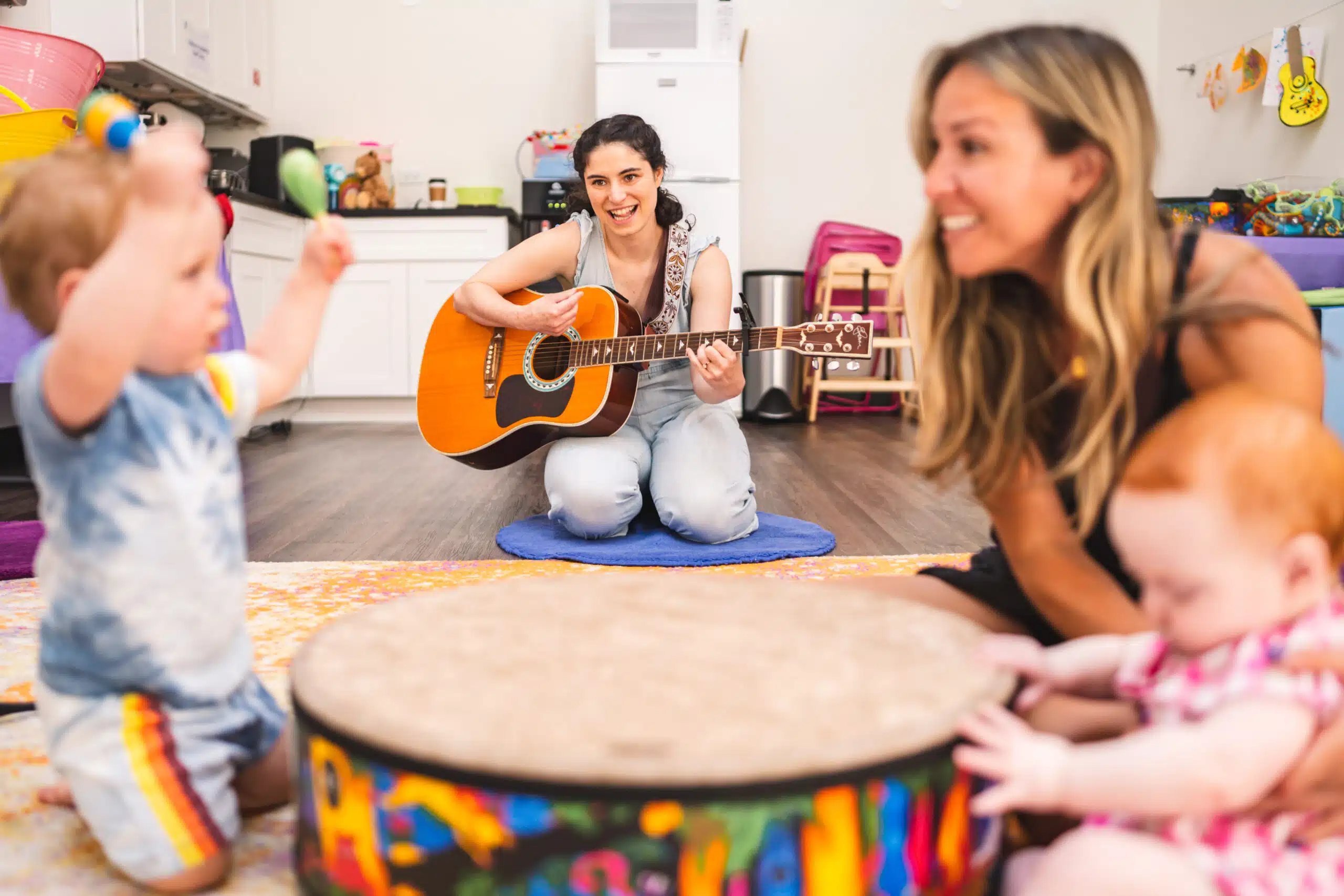Some parents and educators underestimate the positive influence of musical interaction on a baby’s development. While physical activity is often praised for building muscle and teaching body control, integrating music into children’s early years can be equally valuable.
Music powerfully impacts children’s development, boosting emotional understanding, language skills, and memory. It creates a sense of community and culture and becomes essential for learning and enjoyment at home during challenging times.
At Bubbles Academy, we’ve seen how healthy music integrates into a positive learning environment. This article will explore the benefits of music and movement in early childhood development and provide activities you can do with your baby at home to help get them started.
What We Mean by Music and Movement
While dancing combines music with movement for a fun activity, we also include other potential activities. Other aspects combining the two include playing instruments and singing or simply swaying with the beat.
Many daycare and preschool teachers sing nursery rhymes, sing the alphabet song, or dance with their students to promote their growth. Parents can do similar activities at home to build closer connections and memories with their children.
How Music and Movement Help Children Grow
Studies referenced by UNICEF have shown that children, even while still in the womb, enjoy hearing sounds, including music. Even adults can benefit from musical education and motion. As we help children with early childhood development, we add movement to combine music, something they already love, with physical development.
Did you know that little ones under five years old are already able to recognize patterns, differentiate sounds, and understand rhythm? These early developmental milestones are so important and can help them in many different areas of their lives:
- Cognitive Skills: Music and movement help children build their thinking skills and learn new things like recognizing patterns. Some children even start learning how to talk by listening to their parents or singing along to their favorite songs. It’s amazing how much they can learn just by having fun.
- Social Interaction and Growth: When children are young, it’s important to make music and movement a shared experience so they can learn how to move around confidently. As they grow older, these collaborative activities help them develop skills like taking turns and working together with others.
- Imaginative Expression: Art can be an amazing form of self-expression. Whether it’s through music, movement, or other creative outlets, combining different forms of art can help children communicate their emotions and ideas in a positive way. Plus, it can be a great tool for regulating emotions and reducing outbursts.
- Physical Growth and Development: It’s important for everyone, including adults, to keep their bodies active and healthy. For children, it helps them build strong muscles, spatial awareness, and fine motor skills.
How Educators Use Music and Movement in Daily Care
Many educational and care organizations help children throughout the day by using movement or musical cues. For example, if they want the group’s attention, they may say or sing, “All eyes on me,” and add a gesture.
The children, eager to participate, do the movement and repeat a phrase the teacher assigned for them. Activities like these catch their attention and promote coordination and cooperation with others.
They may also use music to transition from one activity to the next, especially if children get restless in between. Moving to the music can help exert some energy and allow them to focus on any other assignments they have.
Educators can also use music and movement as the activity itself for education and developmental learning. For example, singing the ABCs with children can help them learn the letters of the alphabet and its placement. At the same time, children implicitly learn rhythm, musical tones, and patterns.
How You Can Use It at Home
You can grow more positive and closer relationships with your children by integrating music and movement in their early childhood development. Activities can start before they’re born and continue afterward:
- Using music to help your child go to sleep
- Singing to them both in and outside the womb
- Playing music against your stomach to help the brain develop
- Integrating movement by helping them move their arms or legs while singing
- Playing music for specific activities to help them recognize time, like when it’s time for lunch or to change diapers
- Catching or redirecting your child’s attention with music and movement to help them calm down or stay focused
- Playing instruments with them so they can learn how to play and produce melodic sounds while developing their bodies
Learn About Your Musical Heritage
The world of music is so big, and we have access to it in ways people could never have dreamed about! Introduce your kids to the music you listened to growing up. Call grandma and talk about the music she listened to growing up. Put on music from your history, culture, heritage language. Tell stories that go with these songs. Learn old popular dances. Find other media, like movie musicals and music videos, that feature some of these songs.
Music can feel so personal, but is a way of keeping all of us together. When it’s not possible to be together in the same room, music can be the connection we need.
At Bubbles Academy, We Help Children Grow
Our organization runs on the idea that music and movement greatly assist and improve early childhood development. We’ve seen its positive influence on a child’s physical and emotional growth. Having musical and movement cues, activities, and practices has led to happier, more engaged children with a drive to learn.
Our Chicago preschool and prep locations help children have a running start in their futures. Visit our contact page to talk with us and learn how we can help your child shine even brighter than they already do!

